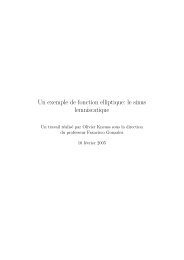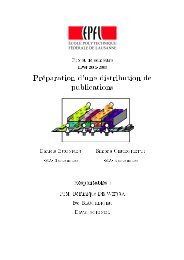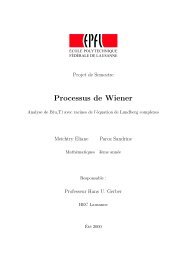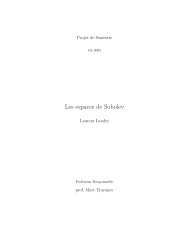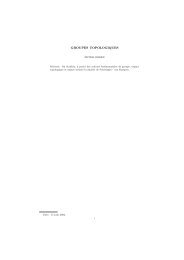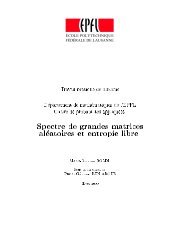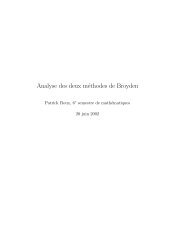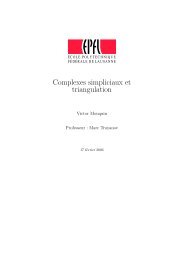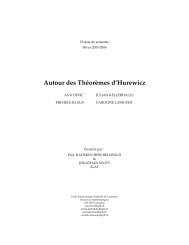Identification du dual topologique de C[a, b] Louis ... - CQFD - EPFL
Identification du dual topologique de C[a, b] Louis ... - CQFD - EPFL
Identification du dual topologique de C[a, b] Louis ... - CQFD - EPFL
You also want an ePaper? Increase the reach of your titles
YUMPU automatically turns print PDFs into web optimized ePapers that Google loves.
Le <strong>du</strong>al <strong>topologique</strong> <strong>de</strong>s fonctions continues<br />
1. Notions preliminaires<br />
Définition 1.1. Soient a, b ∈ R, a < b. On pose<br />
C[a, b] := {f : [a, b] → R : f est continue sur [a, b]}.<br />
Remarque 1.2. On munit C[a, b] d’une structure <strong>de</strong> R-espace vectoriel<br />
en définissant : ∀f, g ∈ C[a, b], ∀λ ∈ R<br />
– (f + g)(x) := f(x) + g(x)<br />
– (λf)(x) := λf(x), ∀x ∈ R<br />
On munit C[a, b] d’une structure d’espace vectoriel normé grâce à l’application<br />
:<br />
‖ · ‖ : C[a, b] −→ [0, ∞)<br />
{ }<br />
‖f‖ := max |f(x)|<br />
x∈[a,b]<br />
Définition 1.3. On définit :<br />
– le <strong>du</strong>al algébrique <strong>de</strong> C[a, b] comme l’ensemble <strong>de</strong>s formes linéaires sur<br />
C[a, b], noté C[a, b] ∗ .<br />
– le <strong>du</strong>al <strong>topologique</strong> <strong>de</strong> C[a, b] comme l’ensemble <strong>de</strong>s formes linéaires<br />
continues sur C[a, b], noté C[a, b] ′ .<br />
Remarque 1.4. C[a, b] ′ ⊂ C[a, b] ∗<br />
Remarque 1.5. L’analyse fonctionnelle nous assure que la propriété <strong>de</strong><br />
continuité peut-être remplacée par le fait d’être borné, mais nous reprendrons<br />
ce point plus en détail.<br />
Définition 1.6. Soit f ∈ R [a,b] .<br />
f est dite monotone croissante si : ∀x, y ∈ [a, b], x < y ⇒ f(x) ≤ f(y)<br />
f est dite monotone décroissante si : ∀x, y ∈ [a, b], x < y ⇒ f(x) ≥ f(y)<br />
Définition 1.7. Soit un intervalle compact [a, b] ⊂ R et n ∈ N. Un<br />
ensemble <strong>de</strong> points {x 0 , . . . , x n } ⊂ [a, b] vérifiant :<br />
x 0 = a, x n = b, x i < x i+1 ∀ 0 ≤ i ≤ n − 1<br />
est appelé une subdivision (d’ordre n) <strong>de</strong> [a, b]<br />
Définition 1.8. Soient a, b ∈ R, avec a < b et f ∈ R [a,b] .<br />
On dit que f est à variation bornée sur [a, b] si ∃K > 0 tel que pour toute<br />
5


![Identification du dual topologique de C[a, b] Louis ... - CQFD - EPFL](https://img.yumpu.com/32808525/5/500x640/identification-du-dual-topologique-de-ca-b-louis-cqfd-epfl.jpg)
